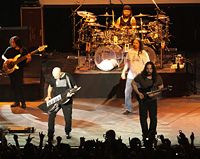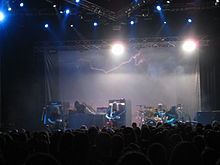- Progressive metal
-
Progressive metal Stylistic origins '80s and '90s:
Progressive rock, heavy metal
'00s-present:
Heavy metal, progressive rock, jazz fusion, psychedelic rockCultural origins Mid 1980s, United States, United Kingdom, Canada Typical instruments Electric guitar, bass guitar, percussion, vocals, keyboards Mainstream popularity Moderate since creation, slowly rising since the mid 1990s in the United States and Europe Derivative forms Djent Fusion genres Technical death metal, mathcore Other topics Timeline of heavy metal, mathcore Progressive metal (sometimes known as prog metal or prog-metal) is a subgenre of heavy metal originating in the United Kingdom and North America in the late 1980s. Progressive metal blended elements of heavy metal and progressive rock music, taking the loud "aggression",[1] amplified electric guitar-driven sound of the former, with the more experimental, complex and "pseudo-classical" compositions of the latter.[2] Progressive metal often kept the conceptual themes associated with progressive rock. Throughout the years, progressive metal has borrowed influences from several other genres, including classical and jazz fusion music.
Whilst the genre emerged towards the late-1980s, it was only until the 1990s that progressive metal achieved some commercial success.[3] Dream Theater, Queensrÿche and Fates Warning are examples of progressive metal bands who achieved a degree of popularity and success; additionally, heavy metal bands such as Metallica incorporated elements of progressive music in their work.[4] Nevertheless, towards the end of the 1990s, progressive metal's popularity started to fade, despite still having a committed fan following.[5] Despite some popularity, progressive metal remained a largely underground genre throughout most of its course,[6] despite some commercial success and a "dedicated following" in the 1990s.[7]
Contents
History
 Dream Theater playing live March 8, 2008
Dream Theater playing live March 8, 2008
The mixing of the progressive rock and heavy metal styles can be traced back to the late 1960s and early 1970s. One of England's heaviest progressive rock bands,[8] High Tide, fused the elements of "metal progenitors such as Cream, Blue Cheer, and the Jeff Beck Group" into their sound.[9] Other bands such as King Crimson and Rush were also incorporating metal into their music,[10][11] as well as Uriah Heep, whose "by-the-books progressive heavy metal made the British band one of the most popular hard rock groups of the early '70s".[12] Rush songs such as "Bastille Day", "Anthem", "By-Tor and Snow Dog", "2112", "The Fountain of Lamneth" and "Something for Nothing" have been cited as some of the earliest examples of progressive metal.[13] Another early practitioner of progressive rock and heavy metal were Lucifer's Friend.[14] Night Sun was also an early band who mixed heavy metal with progressive rock tones, though only releasing one album. However, progressive metal did not develop into a genre of its own until the mid-1980s. Bands such as Psychotic Waltz, Fates Warning, Queensrÿche, and Dream Theater took elements of progressive rock groups (primarily the instrumentation and compositional structure of songs) and merged them with heavy metal styles associated with bands like Judas Priest and Black Sabbath (the former of which had some progressive influences on their early albums). The result could be described as a progressive rock mentality with heavy metal sounds.
These three early flagship bands for progressive metal (Fates Warning, Queensrÿche, and Dream Theater) each had somewhat different sounds. Queensrÿche had the most melodic sound of the three and achieved, with Operation Mindcrime and Empire the genre's most immediate commercial successes, which peaked with the crossover single "Silent Lucidity" reaching number nine on the Billboard Hot 100. Dream Theater drew more heavily upon traditional progressive rock and also built much of their earlier career on the band members' virtuoso instrumental skills, despite also achieving an early - and unexpected - MTV hit with the eight-minute "Pull Me Under" from 1992's Images and Words. Fates Warning were the most aggressive and heavy and arguably had the most in common with the thrash and extreme metal scenes of the time, which led them to be the least accessible of the three bands.
 Porcupine Tree playing live November 28, 2007
Porcupine Tree playing live November 28, 2007
Though progressive metal was, and has remained, primarily an album-oriented genre, this mainstream exposure increased the genre's profile, and opened doors for other bands. Over the 1990s, bands such as Pain of Salvation, Vanden Plas, Threshold, Symphony X, Tool, Andromeda, Porcupine Tree and Arjen Anthony Lucassen's Ayreon project all succeeded in developing their own audiences and signature sounds. In the decade which followed, artists who began their careers outside of the progressive milieu, such as Sweden's Tiamat (originally a death/doom metal act), Green Carnation and Opeth (both formed in the death metal mould), developed a progressive sound and became identified with the progressive metal genre.
Pain of Salvation drew heavily on more obscure 1970s prog acts.[citation needed] Ayreon stayed with the traditional Prog Metal themes, but mixed them with many other influences, prominently rock opera and ambient. Symphony X married progressive elements to power metal and classical music. Tool created a progressive sound using alternative metal elements and odd rhythms. Steve Vai's former singer and heavy metal band Strapping Young Lad's singer and guitarist Devin Townsend combined elements of post metal and ambient with traditional progressive metal on his first two solo albums Ocean Machine: Biomech and Infinity. Mastodon also combined progressive metal with sludge and metalcore elements. Opeth, Skyfire, and Between the Buried and Me combined (in very different ways) their prog influence with death metal. Bands such as 30 Seconds to Mars created a more traditional progressive sound that incorporated elements of space rock.[15][16]
Diversity
Progressive metal can be broken down into countless sub-genres corresponding to certain other styles of music that have influenced progressive metal groups. For example, two bands that are commonly identified as progressive metal, King's X and Opeth, are at opposite ends of the sonic spectrum to one another. King's X are greatly influenced by softer mainstream rock and, in fact, contributed to the growth of grunge, influencing bands like Pearl Jam, whose bassist Jeff Ament once said, "King's X invented grunge.". Opeth's growling vocals and heavy guitars (liberally intermixed with gothic metal-evocative acoustic passages and clean melodic vocals) often see them cited as progressive death metal, yet their vocalist Mikael Åkerfeldt refers to Yes and Camel as major influences in the style of their music.
 Opeth playing live May 30, 2009
Opeth playing live May 30, 2009
Classical and symphonic music have also had a significant impact on sections of the progressive metal genre, with artists like Devin Townsend, Symphony X, Sleepy Hollow and Shadow Gallery fusing traditional progressive metal with a complexity and grandeur usually found in classical compositions. Similarly, bands such as Dream Theater, Planet X and Liquid Tension Experiment have a jazz influence, with extended solo sections that often feature "trading solos". Cynic, Atheist, Opeth, Pestilence, Between the Buried and Me and Meshuggah all blended jazz/fusion with death metal, but in dramatically different ways. Devin Townsend draws on more Ambient influences in the atmosphere of his music. Progressive metal is also often linked with power metal, hence the ProgPower music festival, with bands such as Fates Warning and Conception originating as power metal bands that incorporated progressive elements which came to overshadow their power metal roots.
Progressive metal has also overlapped thrash metal - most famously perhaps with Dark Angel's swansong album Time Does Not Heal, which was famous for its sticker that said "9 songs, 67 minutes, 246 riffs." The band Watchtower, who released their first album in 1985, blended the modern thrash metal sound with heavy progressive influences, and even Megadeth were often and still are often associated with progressive metal, as Dave Mustaine even once claimed that the band was billed as "jazz metal" in the early '80s.[17] The band Racer X would also fall within this genre of technical proficiency featuring Paul Gilbert, a guitar instructor at the Musicians Institute[18] in LA, a tendency evidenced on songs such as "B.R.O." from 1999's Technical Difficulties. The band Voivod also combined elements of thrash metal and progressive metal, specifically on the releases Dimension Hatross and Nothingface, in 1988 and 1989 respectively.
Recently, with a new wave of popularity in shred guitar, the hitherto-unfashionable genre of "technical metal" has become increasingly prevalent and popular in the metal scene. This has led to a resurgence of popularity for more traditional progressive metal bands like Dream Theater and Symphony X, and also has led to the inclusion within the progressive metal scene of bands that do not necessarily play in its traditional style such as thrash/power metallers Nevermore, technical death metal act Necrophagist. These bands are, rightly or wrongly, often labeled progressive metal, as they do play relatively complex and technical metal music which does not readily cleave to any other metal subgenre.
Differences with avant-garde metal
Although progressive metal and avant-garde metal both favor experimentation and non-standard ideas, there are rather large differences between the two genres. The experimentation of progressive metal has a strong emphasis on technicality and theoretical complexity (influenced by jazz music). This is done by playing complex rhythms and implementing unusual time signatures and song structures - all with the use of traditional instruments. For avant-garde metal, most of the experimentation is in the use of unusual sounds and instruments - being more unorthodox and questioning of musical conventions.
See also
- List of progressive metal artists
- Timeline of progressive rock and progressive metal
- Avant-garde metal
Notes
- ^ http://www.allmusic.com/explore/style/progressive-metal-d2952
- ^ http://www.allmusic.com/explore/style/progressive-metal-d2952
- ^ http://www.allmusic.com/explore/style/progressive-metal-d2952
- ^ http://www.allmusic.com/explore/style/progressive-metal-d2952
- ^ http://www.allmusic.com/explore/style/progressive-metal-d2952
- ^ http://www.allmusic.com/explore/style/progressive-metal-d2952
- ^ http://www.allmusic.com/explore/style/progressive-metal-d2952
- ^ Neate, Wilson. "High Tide - High Tide". Allmusic. http://www.allmusic.com/album/r40605. Retrieved 2011-10-10.
- ^ Neate, Wilson (1969-07-08). "Sea Shanties - High Tide". Allmusic. http://www.allmusic.com/album/r40604. Retrieved 2011-10-10.
- ^ Buckley 2003, p. 477, "Opening with the cataclysmic heavy-metal of "21st Century Schizoid Man", and closing with the cathedral-sized title track,"
- ^ Buckley 2003, p. 749, "Rush were throwing off shackles of prog-rock and heavy metal,"
- ^ Thomas, Stephen. "Uriah Heep". Allmusic. http://www.allmusic.com/artist/p5733. Retrieved 2011-10-10.
- ^ [1] Progressive rock reconsidered by Durrell S. Brown
- ^ Rivadavia, Eduardo (2006-12-21). "Lucifer's Friend". Allmusic. http://www.allmusic.com/artist/p19037. Retrieved 2011-10-10.
- ^ Palm, Matthew J. (November 8, 2006). "Jared Leto has a 30 Seconds love affair with fans". Orlando Sentinel (Tribune Company). http://www.highbeam.com/doc/1G1-154107401.html. Retrieved October 28, 2011.
- ^ O'Brien, Jon. "30 Seconds to Mars". Allmusic. Rovi Corporation. http://www.allmusic.com/album/30-seconds-to-mars-europe-r1455111/review. Retrieved October 28, 2011.
- ^ [2][dead link]
- ^ "GIT Welcomes Paul Gilbert | Sep 22, 2006 | News & Events at Musicians Institute". Mi.edu. 2006-09-22. http://www.mi.edu/news/git-welcomes-paul-gilbert. Retrieved 2011-10-10.
References
- Buckley, Peter (2003). The Rough Guide to Rock. London: Rough Guides. ISBN 1-85828-201-2.
Heavy metal Subgenres Alternative metal · Avant-garde metal · Black metal · Christian metal · Crust punk · Death metal · Djent · Doom metal · Drone metal · Extreme metal · Folk metal · Funk metal · Glam metal · Gothic metal · Grindcore · Groove metal · Industrial metal · Metalcore · Neo-classical metal · Nintendocore · Nu metal · Post-metal · Power metal · Progressive metal · Rap metal · Sludge metal · Speed metal · Stoner metal · Symphonic metal · Thrash metal · Traditional heavy metal · Viking metalNotable scenes Culture Heavy metal subculture · Fashion · Subgenres · Bands · Festivals · Umlaut · Headbanging · Sign of the horns
Wikimedia Foundation. 2010.
